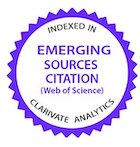Variabilidade nutricional e física de variedades tradicionais de milho (Zea mays L.) cultivados no vale do Juruá, Acre, Brasil
DOI:
https://doi.org/10.1590/1809-6891v24e-74403EResumo
As variedades tradicionais de milho cultivados pelos agricultores familiares constituem-se em fonte de variabilidade genética e são fundamentais para segurança alimentar. Assim, o presente trabalho tem como objetivo, avaliar, com base em componentes físicos e químicos, o comportamento da variabilidade genética de milho tradicional cultivadas em terra firme e praia, na regional Vale do Juruá, estado do Acre. As características constaram da determinação de matéria seca, material mineral, proteína bruta, extrato etéreo, energia bruta, fibra em detergente neutro, amido e digestibilidade in vitro da matéria seca, vitreosidade e densidade dos grãos. Os dados foram analisados mediante estatística descritiva, associado à análise multivariada de componentes principais (PCA), com auxílio do software R. Por meio da PCA, as variedades cultivadas em terra firme e praia formaram 3 grupos distintos, na qual a vitreosidade nos grãos variou de 73,7% a 79,46%, de modo que, as variedades de grãos avermelhadas apresentaram maior presença de endosperma vítreo e maior densidade, havendo uma correlação forte e positiva entre essas variáveis. Já as variedades de grãos amarelas e amarelas-oranges apresentaram maior aderência a energia, amido e maior digestibilidade. Portanto, as variedades tradicionais cultivadas em terra firme e praia, apresentam variações em relação as análises físicas e químicas.
Palavras-chave: valor nutricional; recursos genéticos; conservação on farm.
Downloads
Referências
Pavão AR, Ferreira Filho JBS. Impactos econômicos da introdução do milho Bt11 no Brasil: uma abordagem de equilíbrio geral inter-regional. Revista de Economia e Sociologia Rural. 2011; 9(1): 81-108. Disponível em: http://dx.doi.org/10.1590/S0103-20032011000100004
Caldarelli CE, Bacchi MRP. Fatores de influência no preço do milho no Brasil. Nova Economia. 2012; 22(1): 141-164. Disponível em: http://dx.doi.org/10.1590/S0103-63512012000100005
Lima BC, Dudek, G, Chaves, MHM, Martins AG, Mission VC, Mission RF. Diversidade genética em acessos de milho crioulo. Brasilian Journal of Development. 2020; 6(10): 82712-82726. Disponível em: http://dx.doi.org/10.34117/bjdv6n10-631
Fontinele YR, Santos VB, Nascimento LO, Aragão AC, Nascimento MM, Ferreira AB, Lima AFB, Moreira JGV, Araújo DR. Variability, association and selection of promising characters for breeding creole maize. Journal of Experimental Agriculture International. 2021; 43(4): 31-43. Disponível em: http://dx.doi.org/10.9734/jeai/2021/v43i430670
Vargas CC, Morais RM, Redaelli LR. Infestação de milho crioulo, convencional e transgênico pela lagarta-do-cartucho e pela lagarta-da-espiga e parasitismo de ovos. Revista Brasileira de Milho e Sorgo. 2017; 16(3): 351-360. Disponível em: http://dx.doi.org/10.18512/1980-6477/rbms.v16n3p351-360
Vieira LC, Guerra MP, Barbosa Neto JF. Análise preliminar de germoplasma de variedades crioulas de milho do sul do Brasil. Revista Brasileira de Milho e Sorgo. 2016; 15(3): 557-571. Disponível em: http://dx.doi.org/10.18512/rbms.v15i3.510
Perales G, GolicheR D. Mapping the diversity of maize races in Mexico. Plos One. 2014; 9(12): 1-20. Disponível em: http://dx.doi.org/10.1371/journal.pone.0114657
Môro GV, Fritsche-Neto R. (2017). Importância e usos do milho no Brasil. In: Borém A, Galvão JCC, Pimentel MA, editores. Milho do plantio à colheita. Viçosa, MG: UFV; 2017. p. 09-24.
Nuss ET, Tanumihardjo SA. Maize: a paramount staple crop in the context of global nutrition. Comprehensive Reviews in Food Science and Food Safety. 2010; 9(4): 417-436. Disponível em: http://dx.doi.org/10.1111/j.1541-4337.2010.00117.x
Xu A, Lin L, Guo K, Liu T, Yin Z, Wei C. Physicochemical properties of starches from vitreous and floury endosperms from the same maize kernels. Food Chemistry. 2019; 291: 149-156. Disponível em: http://dx.doi.org/10.1016/j.foodchem.2019.04.024
Souza JML, Álvares VS, Nóbrega MS, Nobre I. Farinha de mandioca de Cruzeiro do Sul: características da identidade regional para a indicação geográfica. In: Souza JML, Álvares VS, Nóbrega MS, editores. Indicação geográfica da farinha de mandioca de Cruzeiro do Sul, Acre. Brasília, DF: Embrapa; 2017. p. 37-51.
Araújo EA, Ker JC, Amaral EF, Lani JL. Potencialidades, restrições e alternativas sustentáveis de uso da terra no Acre. 1 ed. Curitiba, PR: Editora CRV; 2011. 106p.
Amaral EF, Martorano LG, Bergo CL, Moraes JRSC, Lunz AMP, Souza LP, Araújo EA, Bardales NG, Lima MN. Condições agroclimáticas para subsidiar cultivos do café canéfora no Acre. In: Bergo CL, Bardales NG. Editores. Zoneamento edafoclimático para o cultivo do café canéfora (coffea canephora) no Acre. Brasília, DF: Embrapa; 2018. p. 49-88.
Mattar EPL, Silva AMC; OLIVEIRA, K.A.; FRADE JUNIOR, E.F.; CRUZ, L.R. Cultivares tradicionais de milho do vale do Juruá, Acre, Brasil. Disponível em: http://www.ufac.br/site/noticias/2019/campus-floresta-lanca-poster-sobre-cultivaresde-milho. Acesso em: 20/09/2019
Teixeira FF, Costa FM. Caracterização de Recursos Genéticos de Milho. Sete Lagoas, MG: Embrapa Milho e Sorgo; 2010. 10p. (Comunicado Técnico, n° 185).
Silva DJ, Queiroz AC. Análise de alimentos: métodos químicos e biológicos. 3 ed. Viçosa, MG: UFV; 2002. 235p.
Tilley JMA, Terry RA. A two-stage technique for the in vitro digestion of forage crops. Journal British of Grassland Society. 1963; 18(2): 104-111. Disponível em: http://dx.doi.org/10.1111/j.1365-2494.1963.tb00335.x
Van Soest, PJ, Robertson JB, Lewis B. (1991). A Methods for dietary fiber, neutral detergent fiber, and nonstarch polysaccharides in rela¬tion to animal nutrition. Journal of Dairy Science. 1991; 74(10): 3583–3597. Disponível em: http://dx.doi.org/10.3168/jds.S0022-0302(91)78551-2
Kniep KR. Mason SC. Kernel breakage and density of normal and opaque-2 maize grain as influenced by irrigation and nitrogen. Crop Science.1989; 29(1): 159-163. Disponível em: http://dx.doi.org/10.2135/cropsci1989.0011183X002900010035x
Dombrink-Kurtzman MA, Bietz JA. Zein composition in hard and soft endosperm of maize. Cereal Chemistry. 1993;70(1): 105-108.
R Development Core Team. R: A Language and Environment for Statistical Computing. R Foundation for Statistical Computing. versão 4.1.1. Vienna, Austria; 2018.
Schmitz D, Villa PM, Schaefer CEGR, Francelino MR. Avaliação de gradiente pedoambiental usando análise de componentes principais (PCA) na antártica marítima. In: Diniz ES, Villa PM. organizadores. Aplicação da linguagem R em análises de vegetação. Ponta Grossa, PR: Atena; 2020. p. 43-55.
Lever J, Krzywinski M, Altman N. Principal componente analysis. Nat Methods. 2017; 14(7): 641–642. doi: https://doi.org/10.1038/nmeth.4346
Piovesan V, Oliveira V, Gewehr CE. Milhos com diferentes texturas de endosperma e adição de alfa-amilase na dieta de leitões. Ciência Rural. 2011; 41(11): 2014-2019. Disponível em: http://dx.doi.org/10.1590/S0103-84782011005000134.
Suleiman R, Willians D, Nissen A, Bern CJ, Rosentrater, KA. (2015). flint corn naturally resistant to sitophilus Zeamais infestation?.Journal of Stored Products Researc. 2015; 60:19. Disponível em: http://dx.doi.org/10.1016/j.jspr.2014.10.007
Pinho RGV, Santos AO, Pinho IVV. Botânica. In: Borém, A, Galvão JCC, Pimentel MA. editores. Milho do plantio à colheita. 2. ed. Viçosa: UFV; 2017. p. 25-49.
Costa FMJ, Dias Júnior GS, Zacaroni OF, Santos JF, Pereira RAN, Pereira MN. Silagem de grãos úmidos de milho de textura dura ou macia em dietas com polpa cítrica para vacas em lactação. Arquivo Brasileiro de Medicina Veterinária e Zootecnia, 2014; 66(1): 203-210. Disponível em: http://dx.doi.org/10.1590/S0102-09352014000100028
Nguna E, Murayama D, Munthali C, Onishi K, Mori M, Tani M, Palta JP, Koaze H, Aiuchi D. Effect of kernel type on hardness and interrelationship with endosperm chemical components of Malawian local maize (Zea mays L.) varieties during storage. African Journal of Agricultural Research. 2020; 16(10): 1449-1457. Disponível em: http://dx.doi.org/10.5897/AJAR2020.15019
Rossi ES, Faria MV, Mendes MC, Possatto Junior O, Faria CMDR Silva, CA, Vaskoski VL, Andrade JM, Gava E. Microscopia do amido e digestibilidade de grãos em híbridos de milho silageiros com diferentes vitreosidades. Revista Brasileira de Milho e Sorgo. 2016; 15(3): 607-618. Disponível em: http://dx.doi.org/10.18512/rbms.v15i3.662
Rossi ES, Faria MV, Mendes MC, Neumann M, Gabriel A, Conte MVD. Bromatological characteristics and ruminal digestibility of grain corn hybrids with different vitreousness in silage maturity. Acta Scientiarum. Agronomy. 2016; 38(3): 337-344. Disponível em: http://dx.doi.org/10.4025/actasciagron.v38i3.28703
Assis FB, Basso FC, Lara EC, Raposo E, Bertipaglia LMA, Fernandes, LO, Rabelo CHS, Reis RA. Caracterização agronômica e bromatológica de híbridos de milho para ensilagem. Semina: Ciências Agrárias. 2014; 35(6): 2869-2882. Disponível em: http://dx.doi.org/10.5433/1679-0359.2014v35n6p2869
Viana MCM, Freire FM, Ferreira JJ, Macêdo AR, Canrarutti RB, Mascarenhas MHT. Adubação nitrogenada na produção e composição química do capim braquiária sob pastejo rotacionado. Revista Brasileira de Zootecnia. 2011; 40(7): 1497-1503. Disponível em: http://dx.doi.org/10.1590/S1516-35982011000700014
Pineda-Hidalgo KV, Vega-Alvarez E, Calderon-Zamora L, Salazar-Salas NY, Gutierrez-Dorado R, Reyes-Moreno C, Bello-Perez LA, Lopez-Valenzuela, J.A. (2015). Physicochemical, structural, and proteomic analysis of starch granules from maize landraces of Northwest Mexico. Cereal Chemistry. 2015; 92(3): 320-326. Disponível em: http://dx.doi.org/10.1094/CCHEM-05-14-0099-R
Yang J, Fu M, Ji C, Huang Y, Wu Y. Maize Oxalyl-CoA Decarboxylase1 Degrades Oxalate and Affects the Seed Metabolome and Nutritional Quality. The Plant Cell. 2018; 30(10): 2447-2462. Disponível em: http://dx.doi.org/10.1105/tpc.18.00266
Hoffman PC, Esser NM, Shver RD, Coblentz WK, Scott MP, Bodnar AL, Schmidt RJ, Charley, R.C. Influence of ensiling time and inoculation on alteration of the starch-protein matrix in high-moisture corn. Journal of Dairy Science. 2011; 94(5): 2465–2474. Disponível em: http://dx.doi.org/10.3168/jds.2010-3562
Geron LJV, Cabral LS, Trautmann-Machado RJ, Zeoula LM, Oliveira EB, Garcia J, Gonçalves MR, Aguiar RPS. Avaliação do teor de fibra em detergentes neutros e ácido por meio de diferentes procedimentos aplicados às plantas forrageiras. Semina: Ciências Agrárias.2014; 35(3): 1533-1542. Disponível em: http://dx.doi.org/10.5433/1679-0359.2014v35n3p1533
Zilic S, Milasinovic M, Terzic D, Barac M, Ignjatovic-Micic. Grain characteristics and composition of maize specialty hybrids. Spanish Journal of Agricultural Research. 2011; 9(1): 230-241. Disponível em: http://dx.doi.org/10.5424/SJAR/20110901-053-10
Medeiros SR, Marino CT. Carboidratos na nutrição de gado de corte. In: Medeiros SR, Gomes RC, Bungenstab DJ. editores. Nutrição de bovinos de corte: fundamentos e aplicações. Brasília, DF: Embrapa; 2015. p. 45-62.
Henz JR, Nunes RV, Pozza PC, Furlan AC, Schere, C, Eyng C, Silva WTM. Valor energético de diferentes cultivares de milho para aves. Revista Semina: Ciências Agrárias. 2013; 34(5): 2403-2412. Disponível em: http://dx.doi.org/10.5433/1679-0359.2013v34n5p2403
Vázquez-Carrilo G, García-Lara S, Salinas-Moreno Y, Bergvinson DJ, Placios-Rojas N. Grain na tortilla quality in landraces na improved maize grown in the highlands of Mexico. Plant Foods For Human Nutrition. 2011; 66(1): 203-208. Disponível em: http://dx.doi.org/10.1007/s11130-011-0231-7
Tighe P, Duthie G, Vaughan N, Brittenden J, Simpson WG, Duthie S, Mutch W, Wahle K, Horgan G, Thies F. Effect of increased consumption of whole-grain foods on blood pressure and other cardiovascular riak marker in healthy middle-aged person: a randomized controlled trial. The American Journal Of Clinical Nutrition. 2010; 92(4): 733-740. Disponível em: http://dx.doi.org/10.3945/ajcn.2010.29417
Sánchez-Toledano BI, Kallas Z, Gil JM. Importancia de los objetivos sociales, ambientales y económicos de los agricultores en la adopción de maíz mejorado em Chiapas, México. Revista de la Facultad de Ciencias Agrarias. 2017; 49(2): 269-287.
Dongmo H, Tambo ST, Teboukeu GB, Mboukap AN, Fotso BS, Djuidje MCT, Klang JM. (2020). Effect of process and variety on physic-chemical and rheological properties of two corn flour varieties (Atp an Kassai). Journal of Agriculture and Food Research. 2020; 2:10075. Disponível em: http://dx.doi.org/10.1016/j.jafr.2020.100075
Perkel AY, Çalik A, Alatas MS, Kuter E, Cengiz O, Omurtag GZ, Inan G. Evaluation of correlations between nutrientes, fatty acids, heavy, and deoxynivalenol in corn (Zea mays L.). Journal of Applied Poultry Research. 2019; 28(1): 94-107. Disponível em: http://dx.doi.org/10.3382/japr/pfy023
Mesquita FR, Lima MO, Araújo JM, Ribeiro OAS, Craveiro RL. Composição centesimal de frutos típicos da região do Vale do Juruá-Amazônia Ocidental. Enciclopédia Biosfera. 2014; 10(19): 2849-2857.
Lim S, Yi G. Investigating seed mineral composition in Korean landrace maize (Zea mays L.) and its kernel textura specificity. Journal Of Integrative Agriculture. 2019; 18(9): 1996-2005. Disponível em: http://dx.doi.org/10.1016/S2095-3119(18)62055-6
Downloads
Publicado
Como Citar
Edição
Seção
Licença
Copyright (c) 2023 Ciência Animal Brasileira / Brazilian Animal Science

Este trabalho está licenciado sob uma licença Creative Commons Attribution 4.0 International License.
Autores que publicam nesta revista concordam com os seguintes termos:
- Autores mantém os direitos autorais e concedem à revista o direito de primeira publicação, com o trabalho simultaneamente licenciado sob a Licença Creative Commons Attribution que permite o compartilhamento do trabalho com reconhecimento da autoria e publicação inicial nesta revista.
- Autores têm autorização para assumir contratos adicionais separadamente, para distribuição não-exclusiva da versão do trabalho publicada nesta revista (ex.: publicar em repositório institucional ou como capítulo de livro), com reconhecimento de autoria e publicação inicial nesta revista.
- Autores têm permissão e são estimulados a publicar e distribuir seu trabalho online (ex.: em repositórios institucionais ou na sua página pessoal) a qualquer ponto antes ou durante o processo editorial, já que isso pode gerar alterações produtivas, bem como aumentar o impacto e a citação do trabalho publicado (Veja O Efeito do Acesso Livre).






























